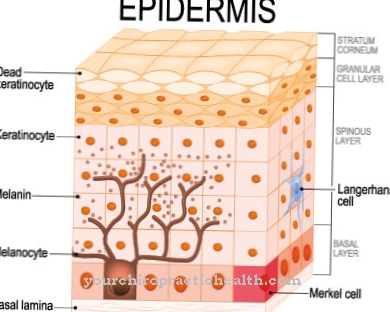In the Nodding sickness is a neurological disease of children and adolescents that is endemic in southern Sudan, Tanzania and northern Uganda. The condition is characterized by constant nodding attacks while eating and gradual physical and mental deterioration. Nodding disease usually leads to death within a few years.
What is nodding sickness?

© Peter Hermes Furian - stock.adobe.com
The Nodding sickness is a disease only found in East Africa. It has been observed in Tanzania and South Sudan since the early 1960s. It is characterized by nodding attacks when eating or in the cold and by gradual mental retardation. A satisfactory explanation for its origin could not be given until today.
The neurotoxicologist Peter Spencer in particular examined the disease more closely. He was able to highlight typical symptoms. At the moment, however, we can only make assumptions about the cause. Peter Spencer described nodding sickness as a slowly progressive fatal dysfunction. He suggested an average lifespan of three to four years for people with this disease.
However, there are also cases where this disease has existed for over ten years. There are even reports of healings. The nodding fits are often related to classic epileptic fits. Through brain wave examinations it was found that the nodding attacks are accompanied by abnormal brain wave patterns that resemble those in epilepsy.
The disease currently only occurs in South Sudan in river settlements with a prevalence of 2.3 to 6.7 percent. By 2008 the disease had spread to some areas of northern Uganda.
causes
So far, only speculations can be made about the cause of the nodding disease. To date it is not clear what causes the disease in the first place and why it only occurs in a limited area. However, it is thought to be an infectious disease or an autoimmune disease caused by an infection.
Another assumption focuses on chronic poisoning from environmental toxins that contaminated the area as part of the civil war. However, there is strong evidence of a connection with the nematode Onchocerca volvulus. It is already known that this worm is spread by the black flies and is the cause of river blindness.
The nematode could be detected in almost all of the patients affected by the nodding disease. It is also remarkable, however, that no cases of nodding disease occur in other areas where this nematode spreads. Therefore the assumption for further co-factors for the development of this disease is obvious. These could be chemicals that have not yet been detected.
There is also the possibility that the roundworm in this area is a carrier of special microorganisms or parasites, which are the true triggers of the nodding disease. An autoimmune disease as a reaction to infection is also believed to be possible.
Symptoms, ailments & signs
As already mentioned, nodding disease is a slowly progressing neurological disease, the main symptom of which is constant nodding movements of the head. The affected child no longer grows and mental development stops. Over time, there is even a mental retardation.
The nodding attacks are triggered while eating or even while watching traditional dishes or when it's cold. If unfamiliar foods such as chocolate are served, nodding attacks do not occur. Even after the meal is over, the nodding fits stop. Between 10 and 20 nodding movements of the head can occur during a seizure. Very strong seizures can even lead to a collapse. This often leads to further damage.
It is not uncommon for children to fall down and seriously injure themselves. It has already happened that those affected have fallen into open fireplaces or on sharp objects. During the seizure, the children also become disoriented and often get lost. The prognosis for the disease is very poor. According to previous experience, it is not curable and is even progressing.
Nodding disease usually ends fatally after several years. There are different statements about the duration of the illness. According to some observations, nodding disease is said to lead to death within three to four years on average. On the other hand, there have also been reports on people who have had this disease for more than ten years. However, there are also statements that a few young people are said to have recovered.
Diagnosis & course of disease
Nodding disease is diagnosed mainly on the basis of the typical symptoms. Brain wave measurements have shown abnormal brain wave patterns during nodding attacks. During MRI examinations, a strong loss of brain mass can be detected. The hippocampus and glial cells also show severe damage. So far, however, there are no indications in the investigations as to the real triggers of the disease.
Complications
As a variant of early childhood epilsepsy, nicking syndrome almost always leads to complications. The associated nodding attacks are unfortunately not the only symptom. However, this symptom alone can cause the affected children to fall during an attack. In doing so, you sometimes suffer serious injuries.
Those affected are no longer in control of their limbs during the attacks. Since the disease mainly occurs in African countries such as Uganda, the children often fall into open fires or touch sharp objects when they fall. In addition, such children often get lost. Without any protection, the disoriented easily become victims of wild animals. In addition, nodding sickness is a disease that is usually fatal.
It progresses and is a serious neurological disease. The biggest problem is the rarity and the narrowly regionally limited area in which the nodding disease occurs. There is no medical care there. Modern diagnostics are just as rare. But even if these things exist, there is still no cure for nodding disease.
Why there are complications and mental retardation in a number of those affected, but not death, is unclear. This may be an indication of a parasitic or infectious trigger that is common in these regions.
When should you go to the doctor?
Parents who notice signs of mental retardation or the typical nodding attacks in their child should have this clarified by a doctor immediately. Long-lasting complaints must be examined and treated by a specialist in order to avert permanent damage. If there is a circulatory collapse, the emergency doctor must be called. The affected child must then be treated in a hospital. If the symptoms described occur during or after a stay in one of the risk areas, a doctor must be consulted immediately.
After returning home, at the latest, the traveler should have a comprehensive medical check-up and, if necessary, treatment. Nodding disease must be treated by a neurologist or other internist. Since the disease is usually associated with long-term damage, therapeutic treatment is also useful. Since nodding disease is a progressively progressive disease, close medical supervision is also necessary. Otherwise, further health problems can arise, which further limit the patient's quality of life.
Treatment & Therapy
Since the causes are completely unclear, there are still no satisfactory treatment methods. So-called anticonvulsants are used. Anticonvulsants are used to treat epileptic seizures. However, there is still no documentation about the extent to which the disease is influenced by these drugs. Antimalarials are also used. No results are published here either.
Outlook & forecast
The prognosis for nodding disease is unfavorable. Despite all medical advances and efforts, the disease ends fatally within a few years of life for the person affected. One difficulty is that the disease has so far only occurred in East Africa. Another challenge is that the cause has not yet been adequately clarified. There are therefore numerous questions that are currently unanswered and thus worsen or even prevent adequate medical care.
The patients suffer from motor disorders as well as decreased mental performance. Uncontrolled seizures occur which, without the fastest possible medical care, result in the patient's immediate death. Due to the existing complaints, the general risk of injury is increased for those affected. Sudden accidents can occur with life-threatening development. Open flames or sharp objects are often a health hazard. The patients are mostly disoriented and are therefore often at the mercy of the wilderness in their homeland. You cannot classify natural dangers and react accordingly.
Since the disease is considered incurable, relatives are often overwhelmed or show negative behavior towards the patient for religious reasons. This worsens the general situation one more time and leads to more severe health conditions.
prevention
So far nothing can be said about the prevention of nodding, as the real causes are not known. There are suspicions that the poor hygienic conditions encourage the onset of the disease. Protection against infection with the nematode Onchocerca volvulus certainly plays an important role in combating nodding disease.
Aftercare
Nodding disease is a poorly researched disease that cannot yet be treated causally. Follow-up care focuses primarily on medically monitoring a cured illness. Regular check-ups ensure that the medication is optimally adjusted and that any complications are clarified quickly. In addition, any incidents are clarified as part of the aftercare.
Parents of affected children must inform the doctor about falls or injuries, for example. It may be useful to prescribe a sedative. Aftercare also includes eliminating possible triggers. For this purpose, parents should consult the responsible doctor on a regular basis.
Follow-up care is provided by the doctor who diagnosed and treated the disease. Sometimes other specialists have to be called in, as this is an extremely rare disease and the knowledge of a general practitioner is usually insufficient. As part of the aftercare, the symptoms are reduced with medication and behavioral therapy.
It is also important to inform the affected children about their disease. A comprehensive education ensures that children who suffer from nodding disease recognize seizures at an early stage and take the necessary preventive measures independently in adolescence and adulthood.
You can do that yourself
Nodding sickness is a mostly fatal disease. Those affected can primarily support the therapy by following the medical guidelines. Above all, strict personal hygiene and a balanced diet are important factors in self-therapy for nodding disease. In addition, a complaint diary should be kept in which the patient notes any accompanying symptoms as well as side effects and interactions arising from the prescribed medication.
Conversations with other affected persons, but also with friends and family members, often help. Talking helps in accepting the disease, especially if the disease is severe. The relatives can assist the person affected and often also contribute to recovery by changing their lifestyle. In this way, a hygienic household helps prevent the infection from spreading any further.
In the event of a serious illness, a place in a palliative care unit or in a hospice should be organized at an early stage. The relatives of the person concerned should speak to the responsible doctor about this. Since the chances of recovery are relatively poor, therapeutic accompaniment may be useful, which supports the person affected and their relatives during the illness and also helps with organizational tasks.

.jpg)



.jpg)


.jpg)



















